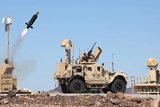NATO funds portable charging technology for Arctic deployment
A US Marine operates a drone in Norway. (Photo: DVIDS)
NATO’s Defence Innovation Accelerator for the North Atlantic (DIANA) recently selected the Canadian company Quaze Technologies to develop an enabling portable, resilient wireless charging solution for drones and unmanned systems to be used in extreme cold environments.
The company was among the winners of the 2025 Arctic Innovation Mobilisation (AIM) competition. It is follow-on activity from the Arctic Warrior Experiment (AWE), which was a technical experimentation event held in Norway, aimed at testing cold-weather gear and other technologies in Arctic conditions.
The 2025 AIM will provide Quaze with €50,000 (US$56,100) to continue to develop, test and refine its solution. Speaking to Shephard, Francis Roy, President and CSO of Quaze, stated that the technology the company is developing can recharge “just about anything”, eliminating “the need to carry a whole lot of batteries or separate charging cables”.
Related Articles
Why the Arctic could be Russia’s next target
How Chinese and Russian ambitions are forcing US posture in the Arctic to shift
Polaris bets on the Arctic market with over-snow reconnaissance vehicle
“We are killing the burden of connecting a wire to the system to recharge,” he explained. “What the military needs is an agnostic technology that can recharge any unmanned systems without human intervention in the most hostile environment.”
The supplier offered its Surface Power Technology to the DIANA competition. The solution has been engineered to enable easy and reliable wireless transmission of energy anywhere on Earth or in space.
The solution is mounted on the equipment that will provide power, such as a car, and turns large surfaces without physical constraint into hubs of wireless for seamless power transmission.
It is powered by magnetic resonance and is scalable to suit various applications, and simultaneously charges multiple devices.
“Right now, it is able to push all the way up to 100 watts. Then anything, no size restriction, can come and grab that power,” Roy remarked.
He explained that it works even in the presence of debris between the transmitter and the receiver. “It is a very resilient system that the operator can rely on and maximise the value of their unmanned systems.”
The technology was on display at the SOF Week 2025 exhibition in Tampa, Florida. On the show floor, the supplier demonstrated its ability to wirelessly recharge equipment for dismounted soldiers.
More from Air Warfare
-
![India readies private sector push as AMCA moves towards 2028 prototype]()
India readies private sector push as AMCA moves towards 2028 prototype
India’s stealth fighter ambitions gain fresh momentum as HAL opens the door to private sector involvement in AMCA Mk1A structural assembly, with strategic support growing for next-gen propulsion and sensor technologies.
-
![BAE Systems reveals new GCAP demonstrator design with plans to fly by 2027]()
BAE Systems reveals new GCAP demonstrator design with plans to fly by 2027
A key part in the trinational Global Combat Air Programme (GCAP), this is the first crewed supersonic aircraft demonstrator to be built and developed in the UK in more than 40 years.
-
![Anduril’s Barracuda-100M completes latest successful test flights]()
Anduril’s Barracuda-100M completes latest successful test flights
The munitions variant of the Barrauda-100 autonomous air vehicle is being tested for the US Army’s High-Speed Manoeuvrable Missile (HSMM) testbed programme, with further flight tests expected in 2026.





















